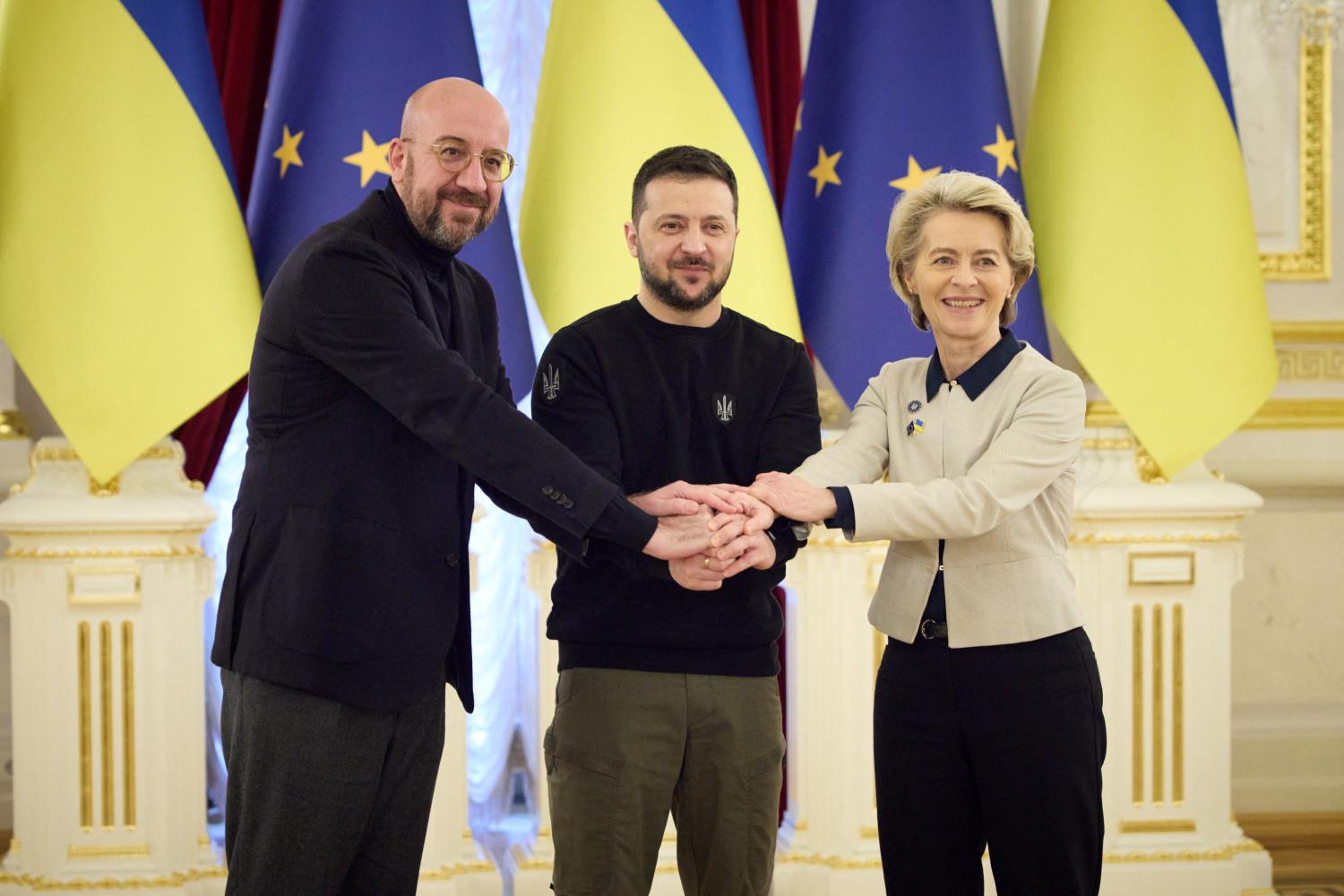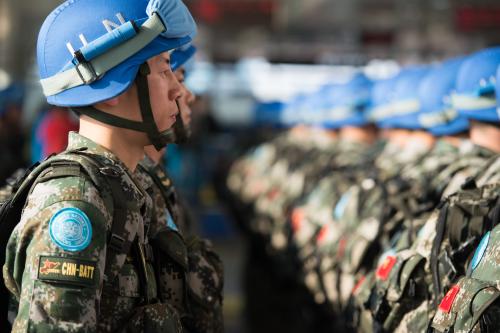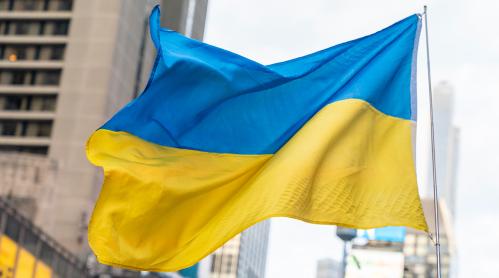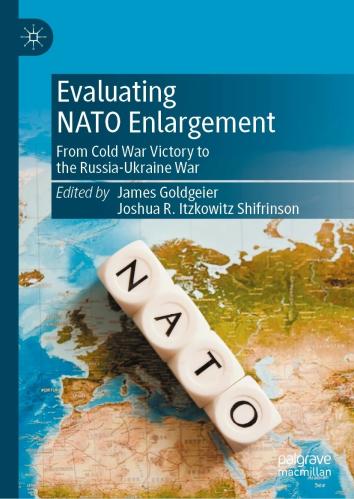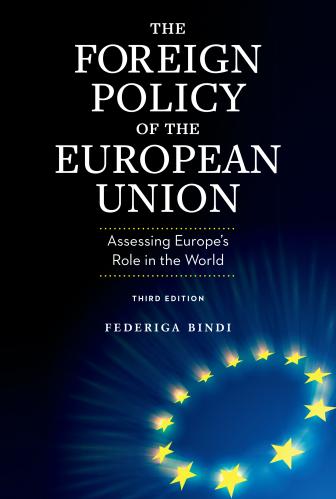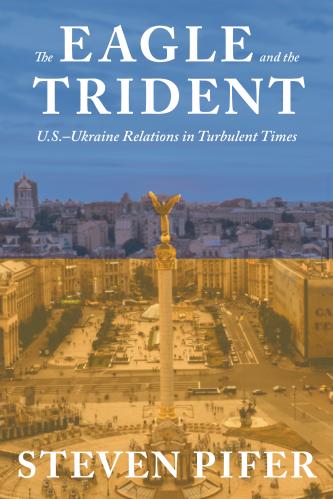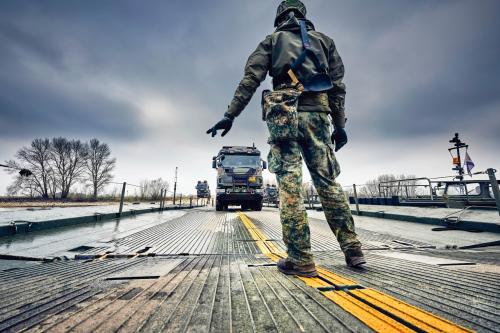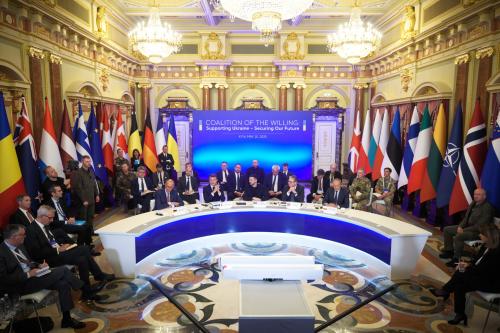This piece is part of a series of policy analyses entitled “The Talbott Papers on Implications of Russia’s Invasion of Ukraine,” named in honor of American statesman and former Brookings Institution President Strobe Talbott. Brookings is grateful to Trustee Phil Knight for his generous support of the Brookings Foreign Policy program.
Executive summary
On December 16, 2023, the European Council is expected to formally kick off the accession negotiations with Kyiv, following a defined schedule. Ukraine’s accession to the European Union (EU) is necessary and inevitable, but it may prove very costly for the current European member states. The process has huge political, financial, and institutional implications that no one can fully gauge today — particularly because the initiative is likely to open a new wave of enlargement to other countries — and which will immediately put pressure on EU member states’ commitment and thereby on EU cohesion. The challenge of integrating Ukraine into the EU requires Europe to find ways of deciding more promptly and efficiently on matters of common concern. Such institutional improvements are of essential importance for the EU, but they cannot be disconnected from the use of its resources. The EU needs larger financial resources of its own, and it must set up a European spending and taxation capacity to bolster its budget before its enlargement to Ukraine and the other Eastern European countries takes place. To effectively use this larger fiscal capacity, the EU needs institutions that European citizens believe are responsible stewards of their money, as well as for the upstream political choices.
Ukraine’s path to accession
The European Commission’s website states bluntly and unequivocally: “The EU stands united with Ukraine.” Indeed, since Russia’s full-scale invasion on February 24, 2022, the European Union has proved both committed and united. It has provided support to Ukrainians seeking shelter and continued to “offer strong political, financial and humanitarian assistance to Ukraine and impose hard-hitting sanctions against Russia and those complicit in the war.” In the longer term, Brussels has also promised to open its door for Kyiv’s accession to the EU, giving the Ukrainian people the prospect of stability and protection from Russia.
Joining the EU might become even more of a priority for Kyiv after NATO decided, during its last summit in Vilnius, not to accelerate the procedure for Ukraine’s accession to the alliance. In its final communiqué, the summit acknowledged that NATO “will be in a position to extend an invitation to Ukraine to join the Alliance when Allies agree and conditions are met.” While this statement came as a cold shower for Ukraine, Ursula von der Leyen, the president of the European Commission, acknowledged in Vilnius the “amazing speed” at which Kyiv is introducing the reforms required to access the EU.
Last January, Ukraine’s prime minister, Denys Shmyhal, announced that Kyiv had “a very ambitious plan to join the European Union within the next two years” and expected to have a pre-entry stage of negotiations already in 2023. But only a few months ago, that agenda seemed simply unrealistic. In May 2022, French President Emmanuel Macron said it could be decades before Ukraine joins and other heads of government were reckoning with a long and uncertain process. But sixteen months after the invasion began, the European Commission is coming closer to Kyiv’s tight agenda and considering launching Ukraine’s accession process to the European Union by the end of 2023. In mid-June, the first report by the commission found that Ukraine had met two of the seven requisites for the accession. A formal and public evaluation is due in October. The next step after that is expected on December 16, with the European Council’s formal kickoff of accession negotiations with Kyiv, following a defined schedule.
There are three reasons for the surprising acceleration of Ukraine’s accession procedure. The first is that most European governments hope that EU accession would push away Kyiv’s request for joining NATO immediately, a step that many European leaders fear would cross Russian President Vladimir Putin’s red line and draw the EU into a frontal clash with Russia; the second is that, however the military campaign ends, it would be too dangerous to leave Ukraine unmoored from Europe and at risk of persistent instability; the third is that Europe has not much else to offer to Kyiv, neither ammunitions nor money. Paradoxically, after spending nearly €69 billion (approximately $77.39 billion in 2023 rates) in support of Ukraine since February 2022 and creating a special facility for providing ammunition to Kyiv, offering a political pathway and a promise of future aid is less expensive today than other options.
Since February 2022, the EU has given a historic amount of financial support to Kyiv. However, Ukraine’s accession may prove much more costly in the medium term, also because the initiative is likely to open a new wave of enlargement to other Eastern European countries. The process has huge political, financial, and institutional implications that no one can fully gauge today, and which tomorrow could put pressure on the EU’s integrity, testing both Europe’s commitment and cohesion.
Challenges of EU enlargement
During its history, the European Union — which was founded as the European Economic Community by Belgium, France, West Germany, Italy, Luxembourg, and the Netherlands in 1957 — has undergone several waves of enlargement. It welcomed Denmark, Ireland, and the United Kingdom in 1973, then Greece, Portugal, and Spain in the 1980s. Renamed the European Union, it admitted Austria, Finland, and Sweden in 1995, then Cyprus, the Czech Republic, Estonia, Hungary, Latvia, Lithuania, Malta, Poland, Slovakia, and Slovenia in 2004’s “big bang,” Bulgaria and Romania in 2007, and Croatia in 2013. Each of these enlargement rounds has created new markets, economies of scale, and prosperity and stability for both the “old” members and the new entrants. They also brought financial costs and institutional adjustments. During the accession processes, the commission helps countries wishing to join the EU to meet the criteria for membership and supports them in implementing related economic and democratic reforms. The difficulty of the task and the costs of the process should not be underestimated. In some cases, notably Turkey but also the Western Balkan countries, the accession process slowed down and lost impetus as a consequence of its political, institutional, and economic complexity.
Romano Prodi, who engineered the “big bang” in 2004 as president of the European Commission, suggested in 2003 to integrate Ukraine too. He called for the same step in 2013, one year before the Russian invasion of Crimea, but in those years the EU’s agenda was absorbed by the internal problems caused by the euro crisis. Eventually, Ukraine submitted a formal application to join the EU four days after the Russian invasion. Nearly four months later, the EU declared the country a candidate, giving a strong sense of European political solidarity with Kyiv as well as warning Putin against persisting in his aggression. Once a member of the European Union, Ukraine would enjoy a right of mutual assistance in case of military aggression under Article 42.7 of the EU Treaty and would be a recipient of huge financial transfers intended to facilitate its integration.
The financial implications of the enlargement process to include Ukraine and other countries bordering Russia are immense.
The financial implications of the enlargement process to include Ukraine and other countries bordering Russia are immense. Rebuilding Ukraine involves transfers in the order of hundreds of billions of euros. In March 2023, a report published by the World Bank, the Government of Ukraine, the European Commission, and the United Nations, estimated that the cost of reconstruction and recovery in Ukraine had reached $411 billion (approximately €383 billion). This estimate only covered the first year following Russia’s invasion, not taking account of the destruction of the Kakhovka dam as well as other recent damages. The cost of reconstruction and recovery is expected to stretch over 10 years, during which both public and private funds will be needed. The World Bank calculates that two-thirds of the money will need to come from public sources. Recently, Ursula von der Leyen, head of the European Commission, proposed that the EU should provide 45% of the funding until 2027 in grants and loans.
Massive resources may also be necessary to accompany the accession of other eastern countries to the EU. The current candidate countries are Albania, Moldova, Montenegro, North Macedonia, Serbia, Bosnia and Herzegovina, Turkey, and Ukraine, while Georgia and Kosovo are considered “potential candidates.” Postponing access to some of those countries may backfire, producing disillusion in the populations and even a rejection of European values. This may be likely in the case of the Western Balkans, whose access to the union was promised 20 years ago.
The Brussels rhetoric has always claimed that enlargements are positive-sum games that benefit all member states. However, increasing the number of countries also reduces the political and economic homogeneity of the European Union, making it more difficult to agree consensually on relevant issues. In March this year, Polish Prime Minister Mateusz Morawiecki gave an example of the distance between newer and older members of the EU. In a speech at Heidelberg in Germany, Morawiecki pushed back against proposals favoring tighter political integration (replacing unanimous voting through the adoption of qualified majority mechanisms, or facilitating advanced cooperation among groups of member states), saying that, in his view, “[N]othing will safeguard the freedom of nations, their culture, their social, economic, political and military security better than nation states,” and warning that a further federalization of the EU would be “illusory or utopian.”
Given the increasing lack of political and cultural homogeneity, a consensus has been maintained through considerable transfers of money from wealthier (mostly Western European) member states to the less wealthy (mostly Eastern) ones. Supporting the economic modernization of the new member states has thus required substantial financial resources from creditor countries. The mobility of capital and labor between Eastern and Western European countries has spurred the competitiveness of Western firms, with substantial benefits for the economy as a whole. However, while for some export-oriented economic systems, mainly the German one, the benefits of integrating the Eastern European economies in the supply chains were huge, for other countries, mainly Italy and France, the integration also brought social costs through migration flows and the transfer of Western European productions to economies where the labor cost was substantially lower.
The populations of the Eastern European member states comprise one-fifth of the total EU population. This shows the preponderant role of Western Europe, reflected also in representation in the European Parliament. The following table highlights the share of EU financial aid currently required by EU member states if income convergence, or bringing the income of countries with lower levels of GDP per capita close to the EU average level, is to be achieved. In the table, the estimate of the future potential needs for net EU financial support to each of the current 27 member states is obtained by calculating the gap between the member state’s income per capita and the EU average level (reduced by a factor of 10%), multiplying it for the population. Through this approximation, we assume that once a member state’s income level reaches 90% of the EU average income level, no further net financial support is needed.
Further, we assume that if enlargement to Ukraine and other current Eastern European candidate and potential candidate countries brings the number of member states to 36, the need for net financial support ends once a member state’s income level reaches 80% of the new EU average level. Assuming the EU budget does not change, the table reveals how the share of financial aid for current member countries would dramatically decline in case of a new wave of enlargement, even without the (currently politically unlikely) accession of Turkey.1 Such an enlargement would also partly dilute Western European preponderance in the EU.
Currently, the European Union does not have an additional budget capable of absorbing the expenses and transfers necessary to help the new candidate countries. At current total budget levels, the gap between the average income of the candidate countries and the rest of the EU implies that countries that so far have been the recipients of EU funds might not be receiving any in the future. Among Western European countries, only Greece and Portugal would receive more money from the EU than they pay in. For some Eastern European member states too, notably Estonia, Slovenia, and the Czech Republic, it might mean moving from the status of countries receiving substantial financial aid to being net creditors. Should strong economic growth in Poland and Hungary persist, at the end of the decade both countries could also stop receiving aid and even be required to contribute to others.
It is not certain that Poland and Hungary, always critical of common institutions and a more integrated European federation, will wish to remain in the union should they have to give up the financial benefits that they currently receive. The hypothesis that Hungarian Prime Minister Viktor Orbán will tax his citizens to transfer resources to other countries is not realistic.
Centrifugal forces
For the European Union, there is a risk of activating centrifugal forces that have been working under the surface for at least a decade. It is since the euro crisis, after 2010, that relations between member states have become less cooperative. Conceptually, the management of that crisis made the principle of national responsibility prevail over that of European solidarity. Countries in financial trouble had to undertake harsh reforms and severe savings as a precondition to the promise of assistance from partners. The relations between financially stronger and weaker countries took on an antagonistic character that has never been fully resolved.
The situation radicalized with the migration crisis of 2015, when the principle of fair redistribution of migration flows was set aside because of the opposition of most eastern member states. Since then, border controls have remained in place which were supposed to be only temporary. If during the euro crisis the antagonism was characterized as the center (Germany) against the periphery (the countries that were assisted were Greece, Spain, Portugal, Cyprus, and Ireland), the dispute over migration caused a new partition between Western and Eastern Europe. However, the dispute took on a significance that was not captured by geography alone but assumed the nature of a confrontation between values: on one side, countries favoring tighter European integration, and on the other side, those protecting the prerogatives of the nation-state. Nationalist politics, most notably associated with Orbán, spread across geographic borders, entering the political debate in most countries. In some, starting with Italy, the rhetoric about the country being “left alone” by Europe in its time of need benefitted the nationalist Euroskeptic parties that are now governing.
The Ukrainian crisis had seemed to strengthen the cohesion of the union, thanks to joint responses of a military nature and the coordinated management of the energy emergency. Since February 2022, the European Council and the Council of the European Union have called on Russia to stop the war immediately. EU leaders constantly requested that Russia cease its military actions, unconditionally withdraw all forces and military equipment from Ukraine, and fully respect Ukraine’s territorial integrity, sovereignty, and independence. In response to the military aggression, the EU has massively expanded sanctions against Russia that had been in place since 2014. So far, the EU has shown unity and strength and has provided Ukraine with the necessary humanitarian, political, financial, and military support.
However, the Ukrainian crisis has also opened a heated confrontation within Europe, between Eastern European countries and the rest. During 2022, attempts by France and Germany to maintain an open dialogue with Russia were inhibited by opposition from the Baltic countries. The latter are aiming for a significant military downsizing of Russia, because, if this does not happen, they fear that they will be the next victims of Moscow’s aggressive expansionism. The new enlargement process, while indispensable, could deepen the latent tensions by increasing the number of countries that are not aligned with the view of the older member states. Macron showed awareness of the need for bridging the distance between “old” and “new” member states in a recent speech at a conference in Bratislava, admitting that Europe had lacked coherence so far: “We provided insufficient guarantees to certain countries at our borders. We did not engage with Russia in a security dialogue for ourselves. Ultimately, we delegated this dialogue to NATO, which was probably not the best means to succeed. And at the same time, we did not break free of dependencies on Russia, particularly for energy, and indeed we even continued to increase them. So, we must be clear-sighted about ourselves.”
The countries of Western Europe have a clear perspective that the center of gravity of the European Union’s priorities has shifted toward the East. The countries of Eastern Europe, however, do not represent a coherent group.
The countries of Western Europe have a clear perspective that the center of gravity of the European Union’s priorities has shifted toward the East. The countries of Eastern Europe, however, do not represent a coherent group. Poland and Hungary are at the opposite poles of Europe’s relationship with Russia, with Warsaw leading the front of countries that want a hard confrontation with Moscow, while Budapest is opposing even the blandest sanctions against the Russian government. The disagreement has annihilated the so-called Visegrad Group, the political alliance of the Czech Republic, Hungary, Poland, and Slovakia. In 2015, after the Russian aggression in Crimea, nine Eastern European countries (Bulgaria, the Czech Republic, Estonia, Hungary, Latvia, Lithuania, Poland, Romania, and Slovakia) formed a new group called the Bucharest Nine, which in a February 22, 2023, summit with U.S. President Joe Biden and NATO Secretary General Jens Stoltenberg, took a strategic position distinct from the rest of Europe. Although Orbán showed his mistrust of the initiative, the group signed a declaration, together, calling for an enhanced military presence of NATO on the eastern flank of the alliance.
However, even this second group of Eastern European countries proved divided in its solidarity with Kyiv when some governments banned imports of grain from Ukraine to protect local producers. In a move that came as a shock to the European Commission, Poland, Hungary, Slovakia, and Bulgaria halted imports of grain and other food products from Ukraine and made it clear in Brussels how contentious integrating Ukraine into the European single market might become. Poland and Slovakia, staunch supporters of Ukraine’s military self-defense, proved not to be ready to give up their economic advantages to the point of calling into question one of the most advanced European federal policies (since in the EU trade decisions are delegated to Brussels, and no longer reside with individual countries).
In March 2023, Lithuania, one of the Baltic states, opposed a common European position in the derogation of sanctions against neighboring Belarus’ export of fertilizers, which are important for emerging countries to stave off a food crisis. Officials in Vilnius claimed that any weakening of sanctions would have played in the hands of Belarusian leader Aleksander Lukashenko, a close ally of Putin. Furthermore, between the various countries of Eastern Europe, there are strong antagonisms linked to projects for the future construction of infrastructures for the transit of goods and raw materials.
The challenge of integrating Ukraine goes beyond material needs. European aid to Ukraine will be predicated on establishing good governance in Kyiv, moving against corruption, and ensuring respect for the rule of law. Those preconditions are sensitive issues for the EU, which faces challenges in having the rule of law respected in Poland and Hungary, as well as structural reforms implemented by some Western governments (Italy among others). The EU must also contend with the difficulties of agreeing on which new infrastructures will link Ukraine with the other European member states, or on which economic industrial sector must be privileged. Ukraine’s massive agricultural export capacity might become a serious problem for France and other subsidized producers. The European military presence in Ukraine, including the use of new technologies, would also be a matter of concern for some EU neighboring countries.
EU institutional reform
The challenge of integrating Ukraine into the EU requires Europe to decide more promptly and efficiently on matters of common concern. In this respect, political fragmentation along national interests is an obvious problem and some form of institutional integration must be advanced. The absence of a united bloc in Eastern Europe justifies France and Germany’s hope to reform the EU’s common institutions by making the EU decisionmaking process more effective through qualified majority voting mechanisms and linking economic aid to compliance with the rule of law — which Poland and Hungary are accused of violating.
This strategy has at least two problems. The first concerns precisely the rule of law, which also inspires the Copenhagen criteria governing the accession of candidate countries to the European Union. If Ukraine’s accession is to be accelerated significantly, the criteria will not be able to be applied strictly and this will also take pressure off Warsaw and Budapest, weakening the Franco-German leverage on countries purporting views not aligned with Europe’s democratic values.
The second problem is that European financial resources are limited. The EU has a long-term budget, also called the Multiannual Financial Framework, a seven-year spending plan, that allows the EU to plan and invest in long-term projects. Of the €1.07 trillion (approximately $1.27 trillion in 2018 rates) allocated for the 2021-2027 period, the largest slices are devoted to farming and regional development or cohesion. Those two slices will be directly impacted by the need of integrating the Ukrainian economy into the single market. What remains of the current European budget is earmarked for current expenses for the functioning of the union, salaries, and utilities. Only last May it was decided that a new item that is of negligible dimension but huge symbolic power would not be added to these outlays: the hundreds of millions of euros in interest spending on the newly mutualized debt that finances the huge assistance projects launched after the recession caused by the COVID-19 pandemic. It is the first time that a sizable European debt has been mutualized and it is vital not to let its cost enter the political debate, dividing creditors and debtors, in times of financial stricture. (The implications are relevant for the Italian government, which mused on building a unique bridging position between Eastern countries — sharing the same nationalist sentiments — and Western countries — sharing similar economic interests.) Europe’s difficulty in supplying ammunition to Ukraine is just one of the symptoms of its lack of capacity in finding the financial and industrial resources to help Ukraine.
Against this backdrop [of Ukrainian integration], it would be necessary, as soon as possible, to increase the size of the common European budget.
Against this backdrop, it would be necessary, as soon as possible, to increase the size of the common European budget. That opportunity presented itself in June when the revision of the Multiannual Financial Framework, the framework of common financial commitments, was planned. On June 20, the European Commission proposed to “reinforce” the EU budget: “Addressing … multiple challenges has pushed the resources of the EU budget to the point of exhaustion, hindering the EU budget’s capacity to address even the most urgent challenges.” Among the priorities, the commission listed first “A Ukraine facility, based on grants, loans and guarantees, with an overall capacity of €50 billion [approximately $55.7 billion] in the period 2024-2027 to cater for Ukraine’s immediate needs, recovery and modernization on its path toward the EU.” However, so far it has never happened that the European budget has been revised before the end of the budgetary period and it is therefore certain that any proposal for increasing the budget will cause a very confrontational discussion with an uncertain outcome.
It is precisely the lack of financial resources that makes the European Commission push forward a highly symbolic and relatively inexpensive act (in the short term) such as the formal opening of Ukraine’s accession process. In her recent trip to Kyiv, von der Leyen urged the Ukrainian government to accelerate reforms as fast as possible in order to formally comply with the Copenhagen criteria in the short term.
The EU’s political investment in Ukraine’s accession is too strong to be reversed. However, the change in European political and financial relations caused by the enlargement of the union to the east already raises very pressing questions about the political and financial stability of the union itself.
To stave off the risks inherent in the enlargement, France and Germany need to find an agreement about their relationship with Eastern European countries and take bold initiatives. In its coalition contract of December 2021, the German government had a very ambitious EU reform agenda. Chancellor Olaf Scholz proposed to call a European Convention for a major reform of the way the EU works. The convention was intended as a follow-up to the Conference on the Future of Europe that had been launched by the European Commission before the war in Ukraine. Disagreement on several issues between Germany and France led Scholz to move to a less ambitious agenda for reforming the European Union, possibly without changing its founding treaties. Both Paris and Berlin agreed that the EU institutional reforms had to precede the enlargement and are now focusing on the adoption of a qualified majority voting mechanism that would facilitate a common position on fiscal and foreign policy issues. In the text of the joint declaration of January 22, 2023, Scholz and Macron stated that:
“To strengthen the EU as a geopolitical actor and in order to prepare the EU for future enlargements, we need to work on the reform of the European institutions. For the functioning of an enlarged European Union we have to ensure efficient decision making, also taking up the expectations of citizens expressed during the Conference on the Future of Europe. We will discuss concrete proposals to strengthen the EU’s capacity to act both in the shorter and the longer term, also with our partners in the European Union to pave the way for discussions about the good functioning of the EU in the coming years. Our countries are open to treaty revision if necessary to achieve the goals we have set ourselves and provided a consensus is found among the 27 Member States of the EU.”
For the short term, France and Germany want to widen the fields where qualified majority voting applies in the council to overcome existing deadlocks, such as on certain areas of common foreign and security policy and taxation. To this end, they advocate the use of the so-called “passerelle clauses” that permit avoiding unanimity in some fields as well as mechanisms of “constructive abstention.” They also have not ruled out “enhanced cooperation” among groups of countries, a procedure where a minimum of nine EU member states are allowed to establish advanced integration or cooperation in an area within EU structures but without the other members being involved. The effectiveness of common decision procedures is today completely inadequate but modifying the voting mechanism may fall short of making it more functional while raising internal antagonism within the EU.
Institutional improvements are of essential importance for the EU, but they cannot be disconnected from the use of its resources. The EU needs larger financial resources of its own; it must set up a European spending and taxation capacity to bolster its budget before the union’s enlargement to Ukraine and the other Eastern European countries takes place. For this to be possible, the EU needs institutions that European citizens believe are responsible stewards of their money, as well as for the upstream political choices. A qualified majority voting mechanism will not solve the problem of analyzing, selecting, and implementing indispensable common projects. Without progress in political integration, the European Union is destined to be reduced to an arena for contentious bargaining over national interests and sooner or later may perish under its weight, realizing one of Putin’s most coveted wishes.
-
Acknowledgements and disclosures
The author would like to thank Constanze Stelzenmüller and Ted Reinert for their feedback as well as Adam Lammon for editing and Rachel Slattery for layout. Reinert, Slattery, and Emily Adams worked on the table.
-
Footnotes
- At NATO’s Vilnius summit, Turkish President Recep Tayyip Erdoğan had attempted to link Sweden’s accession to Turkey’s own EU membership process, but the idea was rejected by the European Parliament’s foreign affairs committee.
The Brookings Institution is committed to quality, independence, and impact.
We are supported by a diverse array of funders. In line with our values and policies, each Brookings publication represents the sole views of its author(s).

